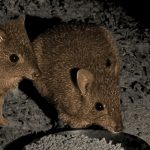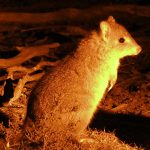WOYLIE
The Woylie: Guardian of Australia’s Forest Floors
Beneath the gentle moonlight of south-western Australia, a small, elusive marsupial scurries through the undergrowth. This is the Woylie, also known as the Brush-tailed bettong—a creature as endearing as it is ecologically significant.
A Closer Look: What is a Woylie?
The Woylie belongs to the Potoroidae family, sharing its lineage with potoroos and rat-kangaroos. About the size of a rabbit, the Woylie’s most striking features are:
- Silky grey-brown fur, blending seamlessly with the woodland shadows
- A brush-like tail, darkening towards the tip, used for balance and occasionally to carry nesting material
- Large, expressive eyes and elongated ears, ideal for detecting faint sounds in the night
Home Among the Shrubs
Once widespread, the Woylie now shelters in the forests and woodlands of south-western Western Australia. Here, dense thickets offer both food and protection. The scent of eucalyptus hangs in the air, mingling with the earthy perfume of leaf litter—the perfect environment for a creature that thrives in the cover of darkness.
The Whispering Night: Woylie Communication
While generally quiet, Woylies can emit soft grunts and gentle squeals, especially when startled or interacting with their young. These subtle sounds drift through the understorey, rarely drawing the attention of larger predators.
Ecosystem Engineers: The Woylie’s Role
Woylies possess strong forelimbs for digging, their claws parting the cool, moist earth in search of food. Their diet includes:
- Underground fungi (truffles and mushrooms)
- Seeds
- Tubers
- Insects and small invertebrates
This foraging behaviour is crucial. By unearthing fungi and dispersing their spores, Woylies help maintain healthy soil and promote plant growth. Their digging also aerates the ground, aiding moisture retention and seed germination. For this, they are celebrated as ecosystem engineers.
Life Cycle: A Story of Resilience
Woylies breed throughout the year, with peaks in autumn and spring. Their reproductive cycle is remarkable:
- Gestation lasts just 21 days.
- A single young is born, tiny and undeveloped, and crawls into the mother’s pouch.
- Pouch life continues for about three months, where the young Woylie grows safe and warm.
- Once emerged, the juvenile stays close to its mother until fully weaned.
Despite their vulnerability, Woylies demonstrate a strong instinct for survival, with a lifespan of four to six years in the wild.
Perils and Predators
Woylies are always alert. The rustle of a leaf or the snap of a twig could signal danger. Their main threats include:
- Predation by foxes, feral cats, and dogs (introduced species)
- Native predators such as birds of prey and carnivorous marsupials
- Habitat loss due to land clearing and bushfires
Their powerful hind legs allow them to leap away from danger, but even agility has its limits.
Conservation: Hope for the Future
Today, the Woylie is listed as Critically Endangered. Conservation efforts focus on:
- Restoring habitat by replanting native vegetation
- Controlling invasive predators through targeted management
- Research and monitoring to better understand their needs
- Public education encouraging responsible pet ownership and appreciation for native wildlife
Why Their Survival Matters
The Woylie’s story is more than just a tale of one species. It is a reflection of the delicate interconnections that sustain Australia’s unique ecosystems. When we protect Woylies, we safeguard the health of the forests and countless other species that depend on them.
A Night in the Woylie’s World
Picture a crisp, starry evening. The air is tinged with the scent of eucalyptus and damp earth. Underfoot, the soil is soft, occasionally disturbed by the digging of a determined Woylie. You hear a distant, gentle grunt—a reminder that, even in the quietest corners of Australia, life flourishes in secret.
Conclusion
The journey of the Woylie is a testament to resilience, adaptation, and the profound influence even the smallest creatures can have on their environment. By learning about and protecting the Woylie, we honour Australia’s natural heritage and affirm our collective responsibility to nurture and conserve the wonders of the wild.
| Common Name | Scientific Name | Status | Key Role |
|---|---|---|---|
| Woylie / Brush-tailed bettong | Bettongia penicillata | Critically Endangered | Ecosystem Engineer |
Let us celebrate the Woylie—not only for its charm, but for its vital place in the story of Australia’s living landscapes.


